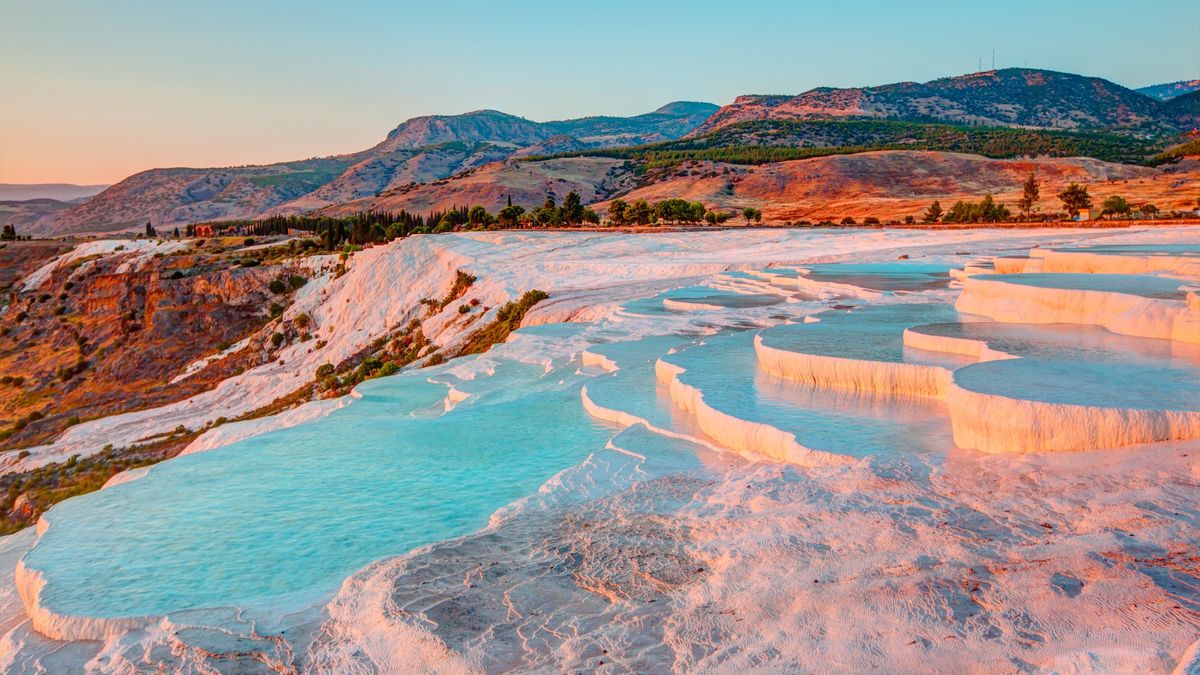QUICK FACTS
Name: Travertines of Pamukkale
Location: Denizli province, southwest Turkey
Coordinates: 37.92387293371705, 29.123346443836517
Why it’s incredible: Despite their snowy appearance, the travertines hold boiling thermal water.
Pamukkale is a town in Turkey that’s famous for its dazzling travertine terraces and thermal water pools. The name, which means “cotton castle” in Turkish, hints at the height and snow-white color of the landmark, which stands in stark contrast to the surrounding arid plain.
Travertine is a type of rock made mostly of calcium carbonate that is deposited from mineral-rich spring water. Pamukkale is home to hot springs that bubble up at the top of a 660-foot-tall (200 meters) cliff overlooking the town. The water drips down over the mountainside, coating the rocks in calcium carbonate that has accumulated over millennia to form a white limestone crust.
The travertines of Pamukkale have grown so thick, they resemble a small glacier from above and afar.
Related: Fairy Chimneys: The stone spires in Turkey that form ‘the world’s most unusual high-rise neighborhood’
Pamukkale’s travertines may look like a winter wonderland, but they’re situated in a warm, sun-kissed part of southwestern Turkey.
The water flowing down the slopes is also warm — between 66 and 135 degrees Fahrenheit (19 to 57 degrees Celsius), according to NASA’s Earth Observatory — and can reach boiling temperatures. It collects in basins that have formed within the terraced slopes, creating natural hot tubs and infinity pools. These cascade into each other, with stalactites and other limestone formations growing along ledges up to 20 feet (6 m) tall where water has dripped down for thousands of years.
Pamukkale is listed as a UNESCO World Heritage Site, but the listing highlights far more than the site’s effervescent bathing pools. The travertines have drawn visitors since antiquity, with the ancient Greeks, in particular, building thermal baths, monuments and a complex system of canals to bring the spring water to nearby villages and fields.
The Attalid kings of Pergamon — an ancient Greek state that ruled large parts of Asia Minor during the Hellenistic period — established a thermal spa town called Hierapolis near the travertines in the second century B.C., the ruins of which still exist today and are also listed by UNESCO. Previously, the site hosted an ancient cult, according to the U.N. agency.
Hierapolis reached its heyday in the second and third centuries A.D., after the ancient Romans took over and rebuilt the town following an earthquake. Remains dating back to Greco-Roman rule and the later Byzantine period include several baths, a monumental arch, a theater, a necropolis, a nymphaeum (a monument dedicated to water nymphs) and temple ruins.
Notably, some of these monuments, like the Temple of Apollo, stood on top of a geological fault that likely leaked noxious gases into the space between their walls, according to UNESCO.
The ruins at Pamukkale are generally well preserved, but huge numbers of visitors threaten the integrity of the site, according to UNESCO. An area where tourists can swim between ancient columns and marble decorations that collapsed after an earthquake in the seventh century is particularly vulnerable.
Discover more incredible places, where we highlight the fantastic history and science behind some of the most dramatic landscapes on Earth.
